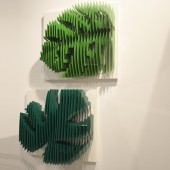Slices Bookshelf by Alessandra Meacci |
Home > Winners > #64309 |
 |
|
||||
| DESIGN DETAILS | |||||
| DESIGN NAME: Slices PRIMARY FUNCTION: Bookshelf INSPIRATION: I designed Slice to transform the most common furniture item,a bookshelf, into a design product that, beyond a practical function, has a strong and deep decorative value. My idea was to turn the bookshelf in a contemporary artistic object, that could be placed on a wall instead of a painting. My personal research is to realize furniture items with a high decorative personality, speaking a modern language and recalling a figurative world, which aim is to enrich our experience of the interiors. UNIQUE PROPERTIES / PROJECT DESCRIPTION: Slices are wall modules that reinterpret the classic bookshelf, turning it into a three-dimensional decorative element, inspired by the world of nature. The bookshelf is a sculptural volume dismantled in a sequence of sections, that are the physical supports for the books. The aim of this project is to arouse wonder with an everyday object; to turn the most common furniture item, the bookshelf everybody has in his house, into an object that awakes curiosity and leads imagination far away. OPERATION / FLOW / INTERACTION: Slice are wall modules that turn the bookshelf into a three-dimensional decorative element, delineated by a sequence of sections that came out of the wall. Moving around the object, you will see the sections compose or break the image of the figurative subject, depending on the angle of the point of view. Moreover, the sections play with the daylight, casting shadows on the wall that change over the hours the day. Thank to this two features, you never have the same image of the object. PROJECT DURATION AND LOCATION: The project started in February 2016 in Padua and finished in April 2016 in Milan, and was exhibited in Salone Satellite at Salone del Mobile in April 2016 FITS BEST INTO CATEGORY: Furniture Design |
PRODUCTION / REALIZATION TECHNOLOGY: The modules are made of aluminium; all the pieces were laser cut. The first step in the realization process has been to develop three dimensional virtual model of the sculptural volume. Then I sectioned it with several planes, to obtain the cutting contour of each piece. The sequence of sections was laser cut, basing on those drawings. The pieces were fixed to a background panel. Sections are the support for books and their sequence outline a three-dimensional element "coming out of the wall". SPECIFICATIONS / TECHNICAL PROPERTIES: Dimensions are different depending on the figurative subject. Leaf subject: Width 650 mm x Depth 250 mm x Height 580 mm. Fishes subject: Width 600 mm x Depth 250 mm x Height 550 mm. Octopus subject: Width 1230 mm x Depth 250 mm x Height 460 mm. TAGS: Bookshelf, decoration, wall-art, wall-decoration, wall-system, metal furniture, wall decor, interiors, bookshelves, sculpture RESEARCH ABSTRACT: My technical research was focused on finding the best type of joint between base and sections. Sections must be painted separately, so they must be single pieces; on the other hand the thin thickness of the aluminium (sections and base are laser cut on 2 mm aluminium sheet) does not allow any weld, without the risk of a deformation (due to the heat) of the pieces. I studied a particular kind of contour for the sections that allow a mechanical joint, and hide the incisions of the base. CHALLENGE: The creative challenge behind this project was to turn the most common furniture item, the bookshelf we have in every house and every office, into an object to awaken curiosity and arouse wonder. To make it, I had to find the right balance between the functional use of the object and the figurative image I wanted create. I made several attempts to find the right spacing between sections, optimal for the books insertion, but also able to allows an easy and incisive reading of the figurative image. ADDED DATE: 2018-02-17 20:08:12 TEAM MEMBERS (1) : IMAGE CREDITS: Alessandra Meacci, 2017. PATENTS/COPYRIGHTS: Copyrights belong to Alessandra Meacci, 2016 |
||||
| Visit the following page to learn more: http://bit.ly/2o7A2xz | |||||
| AWARD DETAILS | |
 |
Slices Bookshelf by Alessandra Meacci is Winner in Furniture Design Category, 2017 - 2018.· Press Members: Login or Register to request an exclusive interview with Alessandra Meacci. · Click here to register inorder to view the profile and other works by Alessandra Meacci. |
| SOCIAL |
| + Add to Likes / Favorites | Send to My Email | Comment | Testimonials | View Press-Release | Press Kit |







